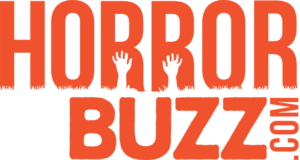Overlook Film Festival 2025 – Irish writer/director Aislinn Clarke‘s 2018 found footage film The Devil’s Doorway focused on the Magadaline Laundries in Ireland, which were asylums operated by Roman Catholic orders for “fallen women.” These asylums lasted from the 18th-late 20th Centuries. Clarke’s follow-up film, Fréwaka, also addresses female trauma at the hands of the Catholic Church in the context of greater national trauma and Irish folklore. Clarke’s second film is a chilling and assured feature that expands upon the themes of her previous work.
Set in a remote Irish town, the film stars Clare Monnelly as Shoo, a care worker who tends to the reclusive and agoraphobic Peig (Bríd Ní Neachtain). Prior to the two even meeting and Shoo taking the job, however, she faces severe loss after her mother commits suicide. This occurs in the opening minutes and sets the heavy and moody tone that haunts the rest of the film. The Catholic imagery is vivid from the outset, too. The mother’s home has red, glowing statues of the Virgin Mary and light-up crucifixes. The vivid red crosses and Virgin Mary figures are especially unsettling, and Clarke repeats this imagery throughout the runtime. Though this film contains no priests, the influence of the Catholic Church is ever-present, especially the personal trauma some of the female characters faced after time in the Magadaline Laundries. The focus on Virgin Mary iconography is important, too, underscoring the very concept of the Virgin Birth and Mary’s outsized rule as a pure woman within Catholicism.
When Shoo does encounter Peig, she learns about the recluse’s own pain. More specifically, a sinister entity captured her on her wedding night. Time and time again, Peig warns Shoo that the entity will return, and it turns out, this time, it’s interested in Shoo, who’s engaged to a Ukranian. Unlike The Devil’s Doorway, Clarke draws much more on Irish folklore here and crafts a hair-raising folk horror film that relies on a few of the subgenre’s familiar tropes, especially in the final act, but even prior to that. For instance, there’s a frequent clash of the rural versus the urban. The townspeople view Shoo as an outsider. She faces glares and snide remarks whenever she visits the local country store. She also tells them that she’s from Dublin, which draws their ire even more. To add, Peig is a woman of profound ritual and superstition. A tree outside of her house contains all kinds of trinkets to ward of the evil spirits.
Clarke’s film contains a lot of potent and frightening imagery. There’s a red door in Peig’s house leading to the basement. Everything about the door and what’s behind it build a creeping sense of dread. Yet, it feels inevitable that either Shoo or Peig will eventually encounter what’s behind that door. Clarke’s direction and writing here are both strong, drawing heavily on Irish history and folklore to spin a personal tale about two women from different generations whose personal traumas and paths eventually collide.
Fréwaka is slow-burn Irish folk horror that successfully weaves Ireland’s national history, including the pain inflicted upon women, with deeply personal stories. This is one soul-stirring and disquieting film that expands upon the themes evident in Clarke’s first film. Peppered with nightmare imagery and a moving narrative, the film unveils uncomfortable truths and one frightening final act.

